Effective Strategies for Eliminating Clover in Your Yard
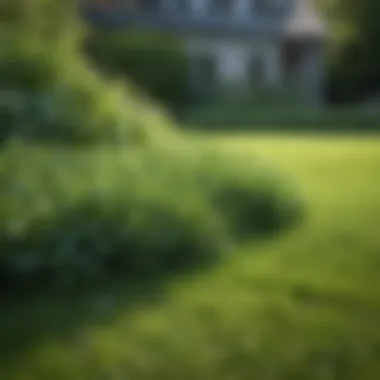
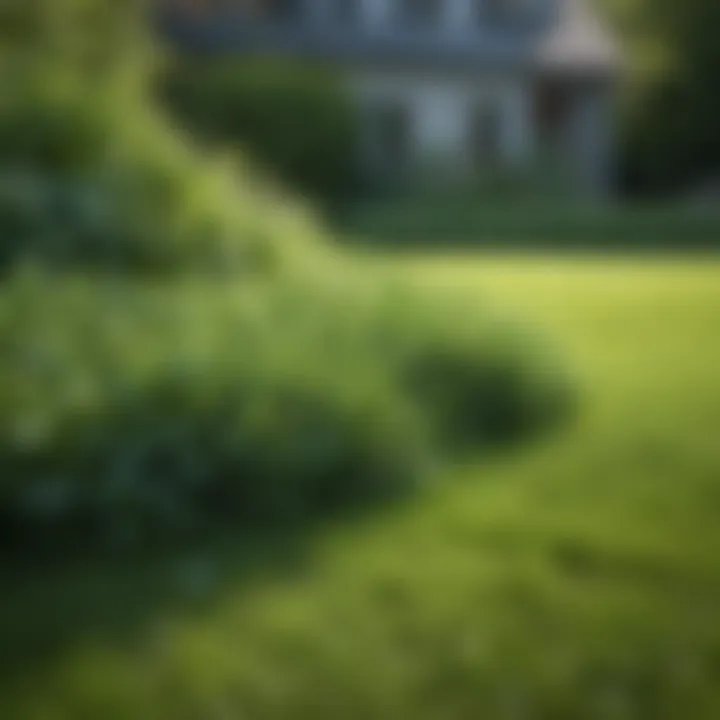
Intro
Clover can find its way into residential yards effortlessly, often becoming an unwelcome sight among the green grass. For many homeowners, its rapid growth can lead to frustration and the pursuit of effective solutions. Understanding how clover thrives, as well as the options available for its removal, are crucial steps towards maintaining a garden that is both healthy and aesthetically pleasing.
In this article, we will explore various methods of eradicating clover from your lawn. From chemical solutions to natural alternatives, each approach comes with its own set of advantages and challenges. Additionally, we'll delve into the ecological implications of clover growth, practical maintenance tips, and preventative strategies to help foster a robust lawn in the long term.
By the end of this guide, you will have a thorough understanding of clover management, enabling you to make informed decisions tailored to your specific needs and the unique conditions of your yard.
Understanding Clover in Your Yard
Understanding clover is an important step for homeowners facing challenges with their yards. Clover can create a significant impact on the aesthetics and functionality of a lawn. This section aims to delineate specific elements to consider about clover, including its prevalence, its characteristics, and how it interacts with the surrounding environment.
There are benefits and drawbacks to clover’s presence. For instance, while clover is often perceived as a weed, it can serve various ecological functions that are beneficial for lawn health. However, if not managed properly, it might dominate the grassy areas, leading to a patchy and less attractive lawn.
Knowing the types of clover present is essential for effective management. A detailed understanding enables homeowners to employ the right strategies whether they choose to tolerate some of it or aim for complete eradication.
Types of Clover Commonly Found
White Clover
White clover, scientifically known as Trifolium repens, is often seen in lawns. It is characterized by its low-growing, mat-like form. This type of clover is a popular choice due to its nitrogen-fixing ability, meaning it can naturally enrich the soil. Its small white flowers also add an attractive appearance. However, the rapid spread of white clover can lead to dense patches that compete with grass. Its resilience might be an advantage in drought-prone areas, but it can be invasive if left unmanaged.
Red Clover
Red clover (Trifolium pratense) is another type found in yards. Its primary feature is its taller growth and pinkish-purple flowers. It serves as a great source of nectar for pollinators, contributing positively to the ecosystem. However, this clover can cause competition for nutrients and sunlight with grass. Its growth habit means it can easily overshadow slower-growing plants. Many consider it beneficial for soil due to its ability to improve fertility, but caution is necessary as it may overtake other plants in a well-maintained lawn.
Creeping Clover
Creeping clover (*Trifolium repens var. subterraneum) is similar to white clover but tends to spread more rapidly with its prostrate growth pattern. This type can form dense mats, often resulting in a softer ground cover. It is frequently used in erosion control due to its ability to stabilize soil. However, its aggressive growth can be problematic, often overshadowing grass and competing for space. Gardeners must be mindful that a creeping variety could lead to a lawn overrun with clover rather than grass.
Ecological Role of Clover
Understanding the ecological benefits of clover helps inform strategies for managing it effectively.
Nitrogen Fixation
Nitrogen fixation by clover is a critical aspect of its role in the lawn ecosystem. Clover can convert atmospheric nitrogen into a plant-usable form, enhancing soil fertility. This feature can lead to reduced need for chemical fertilizers, aligning with sustainable gardening practices. However, homeowners need to be aware that excessively rich soil may encourage weed growth as well.
Support for Pollinators
Clover serves as a vital food source for various pollinators, such as bees and butterflies. The flowers of clover attract these creatures, which can help increase biodiversity in the garden. This ecological support is beneficial to a healthy yard ecosystem. Although many wish to eliminate clover, recognizing its value for pollination can shift perspectives toward a more balanced approach.
Soil Health Benefits
Clover contributes positively to soil health. It can help prevent soil erosion, improve moisture retention, and increase overall soil structure. Homeowners might find that allowing some clover in their yard supports the overall biological activity of the soil. Recognizing these benefits can lead to informed decisions about when to control clover and when to tolerate its presence.
In summary, understanding clover involves recognizing its types and ecological contributions. This understanding is essential for managing clover effectively and achieving a balance between a beautiful lawn and ecological health.
Identifying Clover Infestations
Identifying clover infestations is a crucial step for homeowners aiming to eradicate this persistent plant from their yards. Early detection can mitigate the spreading of clover and help maintain a healthy lawn. Observing signs of clover proliferation, assessing the severity of the infestation, and understanding growth patterns are integral to devising an effective management strategy. This section provides practical insights for understanding how to recognize clover in your yard, thus enabling prompt action against its growth.
Signs of Clover Proliferation
Visible Clusters
Visible clusters of clover are a hallmark of its presence in a yard. Clover tends to grow in patches, which can be easily identified due to their distinct green leaves contrasting with the surrounding grass. Identifying these clusters is beneficial because it signals the need for immediate attention. While they often appear harmless, these clusters can become denser and compete with other plants for resources. Monitoring their growth helps prioritize treatment measures, allowing for a targeted approach to lawn care.
Growth Patterns
Understanding the growth patterns of clover is vital for identification and management. Clover generally spreads through both seeds and the development of stolons, which can root and form new plants. This growth habit means that clover can quickly take over areas if not kept in check. By recognizing its growth patterns, one can predict where clover might spread next, leading to more effective control strategies. Growth patterns also reveal how healthy the surrounding grass is and whether it can outcompete the clover.
Comparative Analysis with Grass
A comparative analysis with grass can clarify clover’s role in a lawn ecosystem. Clover typically grows lower than most grass types and has a rounded leaf shape, making it visually distinct. In situations where clover thrives, it's often a sign that grass health is declining. If clover appears more lush compared to patches of grass, it may signify that care strategies for the grass—such as fertilization or watering—need adjustment. This awareness allows for better management of both clover and grass, ensuring a more balanced yard.
Assessing the Severity of Infestation
Coverage Area Analysis
Coverage area analysis is essential to gauge the extent of clover in your yard. By mapping out clover-infested areas, one can identify high-density zones that require immediate intervention. Such analysis helps prioritize treatment efforts effectively, enabling a homeowner to decide whether spot treatments or extensive applications are needed. Noticing the size of the coverage also indicates how long the clover has been established in the area and can guide future prevention strategies.
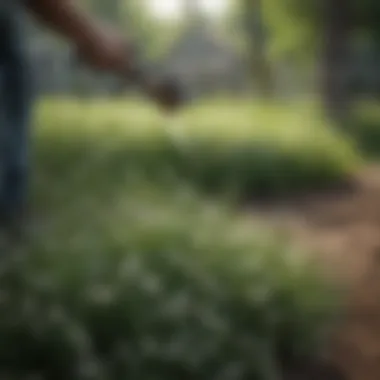
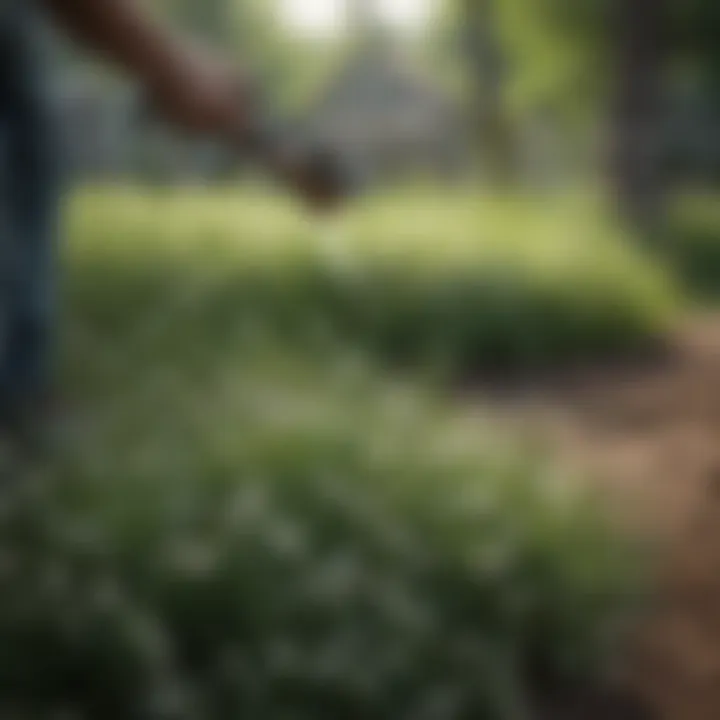
Health of Existing Grass
Evaluating the health of existing grass is a fundamental aspect of assessing clover infestation. When grass is weak, clover can easily fill in and proliferate. A simple visual inspection reveals whether the grass is lush and green or suffering from disease or pest issues. If the grass is not thriving, addressing its health becomes equally important as clover management. Strengthening grass can provide a natural competition against clover, keeping its growth in check.
Root System Assessment
Conducting a root system assessment can provide additional insights into the infestation's severity. Healthy grass typically has a robust root system, which can more easily resist and outcompete clover. By examining root depth and density, homeowners can assess the overall health of their lawn. If the roots are shallow or sparse, clover has a more significant chance of dominating the area. Understanding root systems also informs treatment choices, as managing both systems effectively can lead to long-term lawn health.
Cultural Practices to Attenuate Clover Growth
Cultural practices play a significant role in managing clover growth in residential yards. These strategies focus on fostering a robust and competitive lawn that can naturally suppress clover and other unwanted weeds. Implementing culturally sound lawn care helps maintain soil health and supports the desired grass types while creating an environment less conducive to clover proliferation. Homeowners must consider their mowing strategies and fertilization techniques to make progress in keeping their yards clover-free.
Mowing Strategies
Optimal Cutting Heights
Setting the optimal cutting heights for your grass is crucial. This practice not only encourages healthy grass growth but also helps limit clover development. Studies suggest that grass cut to a height of around 3 inches tends to shade the soil, reducing the light availability that clover requires to thrive. Taller grass can also develop deeper root systems, making it harder for clover to compete. However, cutting too high may lead to other issues, such as thatch formation or fungal diseases. Therefore, maintaining a balance is essential
Frequency of Mowing
The frequency of mowing also impacts clover growth. Regular mowing, ideally every one to two weeks during the growing season, prevents clover from reaching maturity and producing seeds. Frequent mowing encourages lateral growth and can create a dense lawn which competes effectively against clover. However, excessive mowing may cause stress to your grass, thus further guiding clover to establish itself in bare or weakened spots. Therefore, consistently monitoring lawn growth and adjusting the mower frequency is recommended.
Bagging vs. Mulching
When it comes to grass clippings, the choice between bagging and mulching can influence clover growth. Bagging removes clippings, preventing nutrient return to the soil. On the other hand, mulching keeps nutrients in the yard, promoting healthy grass and potentially shading out clover sprouts. This practice can be beneficial, but over time, excessive clippings may build up and smother the grass. Homeowners should assess their specific yard conditions to determine the right approach for their situation.
Fertilization Techniques
Type of Fertilizer
Choosing the right type of fertilizer is a critical factor in maintaining a healthy lawn. Nitrogen-rich fertilizers can promote grass growth, which in turn helps to outcompete clover. Selective fertilizers that are designed for specific grass types help in bolstering desired species. However, over-applying nitrogen can lead to excessive growth and create a lush environment favorable to clover. It's imperative to analyze soil needs and choose the fertilizer type that best supports the grass over the clover.
Timing of Applications
The timing of fertilizer applications is equally important. Fall and spring are generally considered ideal times for fertilizing grass, as it allows the lawn to utilize nutrients when growth is optimal. During these seasons, the grass is more competitive against clover in nutrient uptake. However, improper timing can lead to enhanced clover growth instead. Thus, coordinating fertilization with the growing cycles of grass is beneficial in controlling clover populations.
Impact of Over-treating
Excessive use of fertilizers can have unintended effects. Over-treating can result in weak grass, less competition against clover, and even nutrient runoff that damages local ecosystems. Recognizing the signs of over-fertilization, such as yellowing grass or increased disease vulnerability, can help homeowners adjust their strategies. A balanced approach in fertilization is vital to sustain a healthy lawn and counters clover effectively.
Chemical Control Measures
Chemical control measures are essential for effectively managing clover infestations in residential yards. When clover starts to take over, homeowners may find it challenging to restore their lawns to a desired state. Chemical solutions provide quick results when applied correctly. However, these solutions also come with considerations such as potential impact on the surrounding ecosystem and the health of the soil.
Herbicides: Overview and Types
Herbicides are classified into two primary categories: selective and non-selective. Understanding their differences is crucial for choosing the right product for a specific lawn scenario.
Selective vs. Non-selective Herbicides
Selective herbicides target specific plant types while leaving other vegetation unharmed. This characteristic makes selective herbicides a preferred option when dealing with clover among desirable grasses. Homeowners benefit from maintaining their lawn's health while effectively reducing clover populations. Conversely, non-selective herbicides eliminate all plant life they come in contact with. This trait can be advantageous for clearing out unwanted vegetation but is often unsuitable for areas where desirable grass is present. The danger here is that non-selective options can harm other plants and lead to additional landscaping challenges.
Post-emergent vs. Pre-emergent
Post-emergent herbicides act on clover that has already emerged and is growing actively. This method allows homeowners to tackle established clover effectively. Pre-emergent herbicides, on the other hand, prevent clover from germinating in the first place. They create a barrier in the soil, hindering seed development. Each approach has its place; post-emergent products tend to yield immediate results, while pre-emergents help maintain long-term lawn health by preventing future issues. The timing of applications for both types plays a significant role in achieving desired outcomes.
Application Techniques for Effectiveness
For chemical control measures to be successful, understanding correct application techniques is crucial.
Timing of Application
Timing is a critical aspect of herbicide application. The effective period for treatment often coincides with clover's growth cycle. Applying herbicides during its active growing season maximizes impact. Homeowners find that early morning or late afternoon applications yield better results. The temperature and humidity levels should also be monitored to avoid runoff and ensure optimal absorption.
Weather Considerations
Weather conditions greatly influence herbicide effectiveness. Ideal application occurs when there's no impending rain. A wet surface during application can dilute the herbicide, rendering it less effective. Furthermore, windy conditions can cause drift, affecting non-target areas. Homeowners must ensure favorable weather, ideally aiming for mild temperatures and low winds, to achieve the best results.
Spraying Techniques and Equipment
Proper equipment and techniques are necessary for effective herbicide application. Sprayers must be calibrated to administer the correct amount of product, reducing overspray and wastage. Using a back-pack sprayer or hose-end sprayer can provide precision. Operators should aim for an even coverage across the target area to ensure that every clover plant is effectively treated. Regular maintenance of equipment is also vital for sustained efficacy.
"Using herbicides effectively requires knowledge about specific products, timing, and environmental factors."
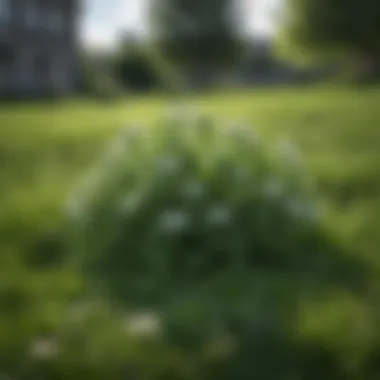
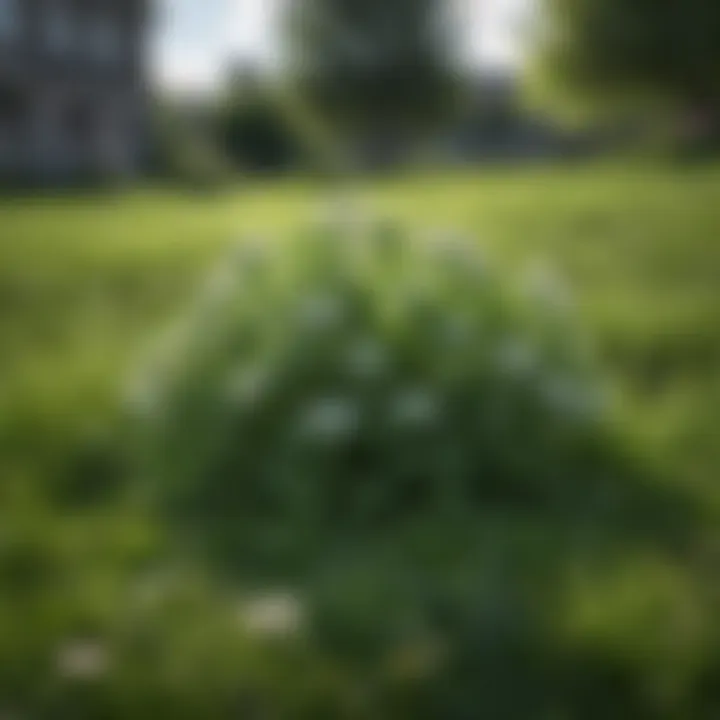
Non-Chemical Alternatives
Non-chemical alternatives play an important role in managing clover infestations in residential yards. These methods provide options for homeowners seeking to reduce their dependence on synthetic herbicides. By embracing natural approaches, not only can you address clover growth effectively, but you also promote a healthier ecosystem. These strategies tend to be safer for pets, children, and beneficial insects. It is crucial to understand how to implement these alternatives effectively to maintain a clover-free lawn.
Manual Removal Techniques
Hand Pulling
Hand pulling is a straightforward method for removing clover from your yard. The process involves grasping the base of the clover plant and pulling it out of the ground. This technique is particularly beneficial because it allows for the complete removal of the root system, reducing the chance of regrowth. One of the key characteristics of hand pulling is that it is immediate and can be done at any time of year when the ground is soft. However, while this method is effective on small patches, it can be labor-intensive for larger areas. Consistency in this practice can yield satisfying results but may require a time commitment.
Using Tools
Using tools for removal, like hoes or hand cultivators, can significantly aid the removal process. These tools enable you to dig deeper and extract the entire root system more effectively than using hands alone. The key characteristic of this method is that it includes more strength and efficiency, which can be advantageous for larger infestations. The unique feature of using tools is the ability to cover more ground in less time compared to hand pulling. However, there is a potential disadvantage, as improper use of tools can damage surrounding grass or soil. Careful application is essential for successful results.
Best Practices for Effective Removal
Employing best practices is crucial for effective clover removal. This includes removing clover during times when the soil is moist, as this facilitates easier pulling. Also, it may require working in small sections to ensure thoroughness. One key characteristic of these practices is that they emphasize proper timing and technique execution. This is a beneficial approach that encourages a systematic method of lawn care. Unique features of these practices include using gloves to protect your hands and avoiding contact with other plants. The main advantage is systematic management of clover growth without resorting to chemicals.
Natural Herbicides: A Closer Look
Vinegar Solutions
Vinegar solutions can serve as a potent natural herbicide, thanks to their high acidiity. This method involves mixing vinegar with water and applying it directly onto the clover. An important characteristic is its safety for the environment, making it a favorable choice for homeowners with kids or pets. The unique feature of vinegar solutions is that they can potentially kill clover almost instantly. However, a disadvantage is that they may also affect desirable plants within proximity, leading to unintended consequences.
Boiling Water Methods
Boiling water methods offer another straightforward alternative for clover elimination. Pouring boiled water directly onto clover will scorch and kill the plants effectively. The primary characteristic of this method is its immediacy, as it provides quick results. Its unique feature lies in its simplicity and low cost. However, one must take caution, as this method can harm surrounding vegetation, similar to vinegar solutions. Targeted application is key to minimize collateral damage.
Corn Gluten Meal
Corn gluten meal is gaining attention as a natural pre-emergent herbicide that can suppress clover growth. Its key characteristic is that it inhibits seed germination, preventing new clover from sprouting. It has become a popular choice in organic gardening due to its safety and effectiveness. The unique feature of corn gluten meal is that it can serve multiple purposes, such as a fertilizer and a weed preventive. However, it may take time to be effective, and proper timing in application is crucial to see results. Failure to apply it correctly can lead to continued clover presence.
Exploring these natural alternatives enriches the dialogue around lawn care, positioning you not just as a homeowner, but as a steward of the lawn's ecosystem.
Long-term Prevention Strategies
Preventing clover from taking over your yard requires a thoughtful approach that emphasizes sustainable practices and long-term care. By focusing on various strategies, homeowners can cultivate a healthy lawn while minimizing the likelihood of clover re-emerging. The strategies discussed here revolve around soil health management and effective planting techniques that benefit overall lawn vitality.
Soil Health Management
pH Level Monitoring
Maintaining an appropriate pH level in the soil is critical. Most grasses thrive in slightly acidic to neutral pH, usually between 6.0 and 7.0. If the pH is too low or too high, it may create conditions that favor clover growth. Regular monitoring allows homeowners to identify issues early. Adjusting soil pH can be accomplished easily through lime or sulfur applications. While beneficial, continually pursuing this method without understanding individual yard conditions could lead to overcorrections.
Organic Amendments
Using organic amendments is another important strategy. Adding compost, well-rotted manure, or other organic matter can improve soil structure, enhance nutrient content, and promote microbial activity. These amendments lead to better root development and grass resilience. This choice is popular due to its natural approach, helping the garden without synthetic chemicals. However, the process must be done periodically as it can be time-consuming and not immediately effective.
Weed Management Practices
Effective weed management practices are vital in preventing clover's aggressive spread. These may include mulching, maintaining mowing heights, and hand-pulling weeds. Keeping a weed-free environment minimizes competition for nutrients and sunlight. This practice is also eco-friendly, reducing chemical herbicide use. Yet, it requires consistent effort and vigilance to manage effectively, potentially overwhelming for busy homeowners.
Planting Techniques
Choosing Appropriate Grass Types
Selecting the right grass type is crucial for long-term success. Cool-season grasses such as Kentucky bluegrass or fescue varieties are often more resistant to clover invasions. They can outcompete clover by forming a dense turf, limiting clover's growth space. This strategy is beneficial as it promotes a flourishing lawn, yet care must be taken to ensure these types fit the climate and soil conditions.
Overseeding Strategies
Overseeding is another effective practice for lawn health and clover prevention. By introducing new grass seed to existing lawns, homeowners can improve density and competition. This method is particularly useful during early fall or spring, when grass grows more vigorously. However, it's essential to water adequately after overseeding, as seed germination can be tricky under low moisture conditions.
Creating Dense Growth
Fostering dense grass growth is essential for ensuring clover doesn't take root. Regular mowing, combined with appropriate fertilization, can help achieve thick, lush grass. Techniques such as lowering mowing height slightly can stimulate growth. However, one must be cautious not to mow too short, as this can weaken the grass and make it more susceptible to disease and weeds.
Effective lawn care combines multiple strategies to create a sustainable environment. A well-managed yard is the best defense against unwanted clover.
Maintaining a Healthy Yard Post-Intervention
Maintaining a healthy yard after addressing clover issues is vital for several reasons. Firstly, a robust lawn promotes the growth of grass and other desirable plants. When intervention is necessary, the goal is not only to eliminate clover but also to enhance the overall health of the landscape. A well-maintained yard reduces the likelihood of future clover invasions, making it imperative for homeowners to adopt effective lawn care practices post-intervention.
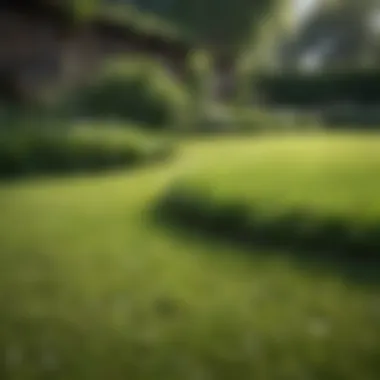
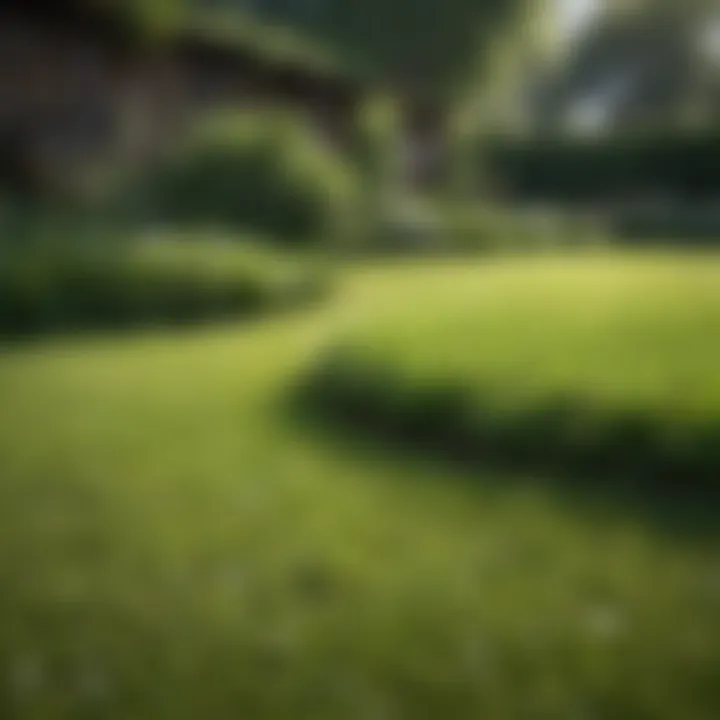
Proper maintenance helps restore nutrients in the soil, fosters a dense grass cover, and minimizes the chances of weed competition. It is essential to create an environment where grass can thrive. The key elements involved in this process include regular care routines, effective watering techniques, and seasonal care approaches, all of which contribute to longevity and health of the lawn.
Best Practices for Lawn Care
Regular Maintenance Routines
Regular maintenance routines are a cornerstone of effective lawn care. This aspect ensures that the yard remains healthy and visually appealing. Establishing a consistent mowing schedule and adhering to a fertilization plan optimizes grass health. Regular maintenance routines allow homeowners to engage proactively with the lawn, thus reducing issues before they escalate. A key characteristic of these routines is their adaptability; they can be customized based on the specific needs of the yard, such as soil type and climate.
One unique feature of regular maintenance is that it can include varied activities tailored to prevent weed growth. However, it requires a commitment of time, which could be seen as a disadvantage for some homeowners.
Watering Techniques
Watering techniques play a crucial role in maintaining a healthy yard. They ensure that the grass receives adequate moisture, crucial for recovery and growth after clover removal efforts. Effective watering is typically adjusted based on the season. The key characteristic is proper timing and amount, which helps avoid over-saturation or drought stress.
A unique aspect of these techniques is the use of deep watering sessions spaced out across the week. This method encourages roots to grow deeper, promoting resilience against weeds. However, if not done correctly, it can lead to runoff and nutrient leaching, proving to be a possible disadvantage.
Seasonal Care Approaches
Seasonal care approaches contribute significantly to the overall health of the yard. They encompass a variety of practices designed to address specific needs during different times of the year. For example, overseeding is ideal in fall while fertilization often takes place in spring. The key characteristic here is timing—knowing when to apply specific treatments can maximize their effectiveness.
Unlike one-time interventions, seasonal care requires ongoing attention, which can be beneficial. However, improper timing can lead to wasted resources or ineffective treatments, which may be considered a disadvantage.
Monitoring and Assessment
Monitoring and assessment are critical for long-term success in lawn care post-intervention. This process involves ongoing evaluation of the yard's condition to identify any signs of clover regrowth or deterioration in grass health. Identifying problems early can prevent more severe issues later on.
Tracking Clover Regrowth
Tracking clover regrowth helps determine the effectiveness of previous clover control measures. This process involves regularly inspecting the yard for new clover patches and assessing their growth rate. A key characteristic of this practice is its proactive nature, allowing quick action to be taken if clover begins to appear. This ensures that clover does not re-establish in the yard.
However, this requires diligence, so some homeowners might find the continuous monitoring to be a disadvantage.
Lawn Health Indicators
Lawn health indicators provide valuable insights into how well the yard is recovering after clover intervention. These indicators include grass color, density, and resilience to foot traffic. They help gauge whether the yard has returned to an optimal state. The key characteristic of tracking these indicators is that they can signal potential problems before they escalate.
The unique feature of assessing health indicators is that they can inform future maintenance decisions. However, misinterpretation of indicators can lead to unnecessary adjustments, which might be seen as a downside.
Adjusting Care Strategies
Adjusting care strategies is necessary for responding to ongoing assessment results. It allows homeowners to refine their lawn care efforts based on the effectiveness of previous actions. A key characteristic of this approach is its flexibility. Homeowners can tailor care plans as they learn more about their yard's needs.
The unique feature of this strategy is that it engages homeowners actively in the care process. However, frequent adjustments can lead to confusion and potential over-management, which may not always be beneficial.
Effective post-intervention practices cannot only prevent the return of clover but also support the overall vigor of your yard.
Evaluating the Ecological Impact of Eradicating Clover
The discussion around removing clover from yards brings forth critical ecological considerations. While homeowners often focus on achieving a certain aesthetic, evaluating the ecological impact of eradicating clover reveals that these small plants can play significant roles in the ecosystem. Understanding these roles is essential for making informed decisions about lawn care and management.
Potential Detriments to Ecosystem
Loss of Nutritional Benefits
When clover is removed, it can lead to loss of nutritional benefits. Clover is a legume, known for its ability to fix nitrogen in the soil. This process improves soil fertility, allowing surrounding plants to thrive. Without clover, nitrogen levels may drop, ultimately leading to poorer grass growth. This characteristic of clover denotes its value in a healthy ecosystem; maintaining such plants can promote overall lawn health. By negating this aspect, homeowners could inadvertently undermine the long-term vitality of their yards.
Effects on Local Biodiversity
Eradicating clover can negatively affect local biodiversity. Clover provides food and habitat for various species, including beneficial insects and pollinators. When these plants disappear, the local ecosystem suffers. This impact highlights clover’s key role in promoting diversity. A loss of biodiversity can lead to a decline in pest control, as natural predators may also diminish. Therefore, removing clover impacts not only the plants themselves but also the larger ecosystem dynamics.
Soil Erosion Risks
Another aspect to consider is soil erosion risks. Clover helps to stabilize the soil with its root system. When clover is removed, there is less root structure to hold soil in place. This can lead to increased erosion, particularly in areas prone to heavy rain. The importance of soil stability cannot be understated; it is vital for preventing loss of topsoil and maintaining landscape integrity. Homeowners need to assess the potential risks of erosion before deciding to eradicate clover from their yards.
Responsible Gardening Practices
Sustainable Practices
Adopting sustainable practices is a way to engage with the environment positively. Sustainable practices include using organic fertilizers, minimizing chemical use, and employing crop rotation. Such practices enhance soil health without compromising ecological balance. Implementing these techniques ensures the beauty of a yard while fostering a healthy ecosystem. They align with the principles of responsible gardening, promoting a more harmonious interaction with nature.
Integrated Pest Management
Integrated pest management (IPM) offers an alternative approach by incorporating ecological principles. Instead of relying solely on chemicals, IPM focuses on monitoring pest populations and using cultural, mechanical, or biological methods to manage them. This system allows for healthier yards and mitigates any adverse effects commonly associated with chemical applications. Homeowners can glean insights from IPM strategies to foster a balanced environment in their garden.
Encouraging Biodiversity
Encouraging biodiversity means providing various habitats and food sources for different species. Homeowners can achieve this by planting a range of species, including native plants. This practice goes beyond simply controlling clover; it creates an enriched environment that supports pollinators and beneficial organisms. Promoting biodiversity ensures a thriving ecosystem that benefits not only plants but also the overall health of the yard.
In summary, evaluating the ecological impact of eradicating clover is crucial. It poses potential risks such as loss of nutritional benefits, effects on biodiversity, and increased soil erosion. Knowing these factors aids homeowners in making informed decisions that support ecological health.















